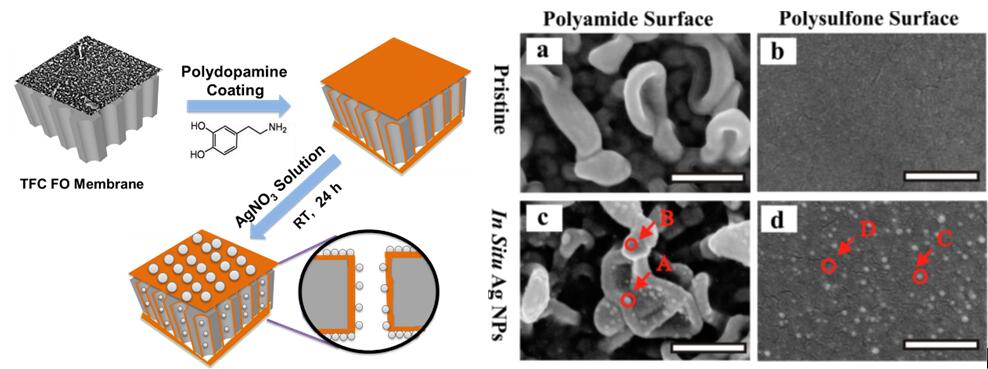|
|
| YIC Researchers Achieve New Progress in Antibiofouling Membranes |
Membrane biofouling, caused by adsorption, deposition, and growth of microorganisms on the membrane surface can greatly compromise its flux and separation efficiency, thus having strong negative effects on the operational sustainability and the cost-efficiency of membrane process. Developing facile and efficient methods to overcome pervasive biofouling problem is supposed to be of paramount importance. Prof. Yunxia Hu ’s research group, from Yantai Institute of Coastal Zone Research (YIC), Chinese Academy of Sciences, has been engaging in high-performance and antifouling membranes for sustainable water purification. Recently, her research group has developed a simple and facile approach to in situ generate silver nanoparticles (Ag NPs) on the filtration membrane for sustainable antibiofouling performances. Mussel-inspired dopamine (DOPA) chemistry was applied to grow polydopamine coating on both surfaces of the filtration membranes, followed by the generation of Ag NPs upon a simple dip coating in silver nitrate aqueous solution. Furthermore, it is the first work to demonstrate that the Ag NPs can be recharged for multiple times upon their depletion, therefore exhibiting strong sustainable bactericidal efficacy. This study developed a simple, universal, and applicable approach for constructing long lasting biofouling-resistant membrane surfaces. This work was published on ACS Applied Materials & Interfaces, 2016, 8 (33), 21666–21673. 
Figure 1. In Situ Synthesis Procedure of Silver Nanoparticles on Both Sides of TFC FO Membrane To reduce the cost of antimicrobial surface construction, a one-pot method was further developed for the chelation of copper ions onto the surface of filtration membrane by simply soaking the filtration membranes in a dopamine solution containing copper(II). The copper ions and O2 together accelerated the polymerization of dopamine under acidic conditions. The deposition of polydopamine coatings and the chelation of copper ions occurred rapidly and simultaneously on the membrane surfaces, regardless of their properties. Given the simplicity and versatility of this approach, combined with the low cost and excellent antibacterial properties of copper, this strategy provides a useful route to mitigating the biofouling of various surfaces. This work was published on Chemical Communications, 2016, DOI: 10.1039/C6CC06015C. 
Figure 2. One-pot chelation of copper ions onto filtration membranes to develop surfaces with antibacterial properties This work is financially supported by National Natural Science Foundation of China, the Key Science and Technology Program of Shandong Province and the Chinese Academy of Sciences. |
|